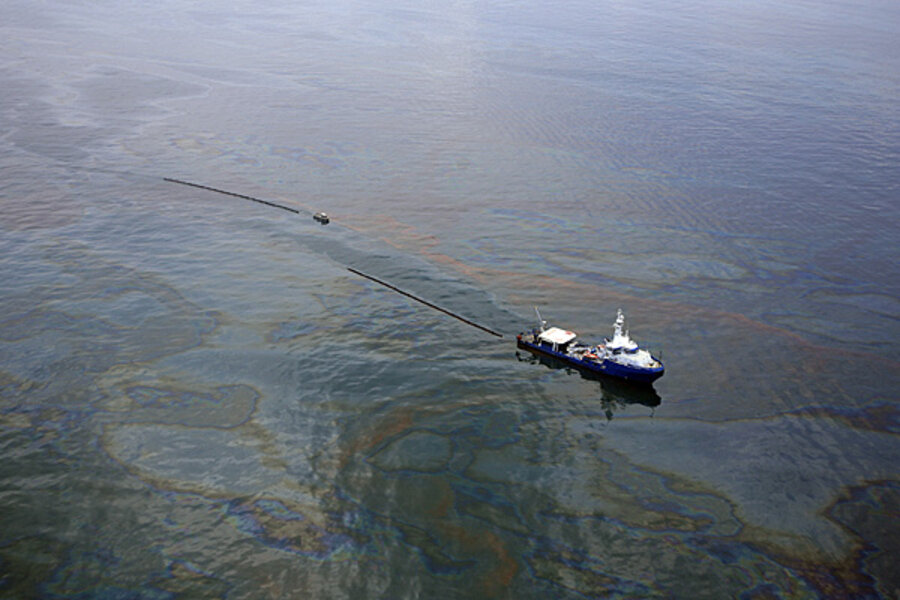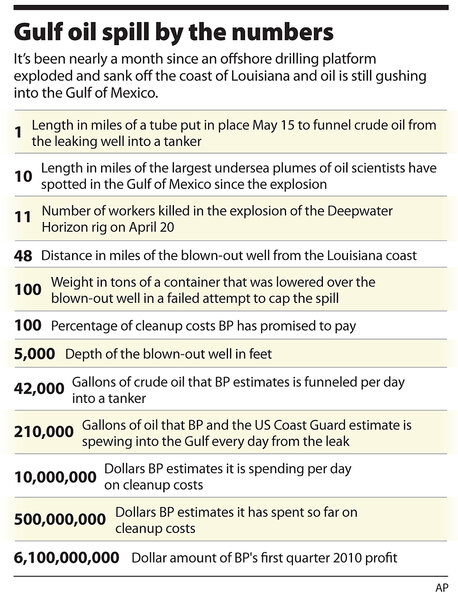Gulf oil spill: 'top kill' could be last best chance to stop leak
Loading...
BP officials are preparing a procedure they say is crucial in containing oil that continues to rush into the Gulf of Mexico at about 210,000 gallons a day.
The “top kill” procedure follows a series of failed containment efforts the company has tried since the Deepwater Horizon oil rig collapsed following an April 20 explosion. The process will involve pumping heavy fluids down two three-inch lines placed inside the wellhead. If successful, the fluids will temporarily stop the oil rush, which would then allow operators to seal the opening with cement. The wellhead, officials say, will never be used again for oil drilling.
The procedure will take place Sunday, officials say, and it appears to mark the company's last best chance to seal the well in the short term. Though BP officials say they will try other procedures if the "top kill" fails, those options are seen as less promising.
IN PICTURES: Louisiana oil spill
The company has waited until now to move forward with the procedure because it was dependent on a series of diagnostic tests. Those include pressure readings to ensure the injection would not make matters worse and an analysis of the condition of the blowout preventer – the emergency valve that sits atop the wellhead but failed to operate.
Because “it takes considerable planning to pull off an operation of this scale,” says BP chief operating officer Doug Suttles, a quick decision to use “top kill” was not possible.
“We think that it is now a sustainable operation,” Mr. Suttles told reporters Wednesday. But he was cautionary, as officials have been for all the procedures before this one.
“We have to remember all that’s being done ... has never been done at this depth before,” he said.
The spill at one month
Thursday will be exactly one month since the explosion that killed 11 people and launched a massive response effort involving BP, federal and state agencies, scientists, and even local fishermen.
Oil is just now reaching the mouth of the Mississippi River and has shown up along the shores of barrier islands. It is said to be moving below the surface in underwater currents. Where it travels and how far it spreads is dependent on weather conditions, including temperatures and storm winds.
The oil is continually shifting direction and speed, officials say, making it difficult to predict where it may settle.
On Wednesday, the National Oceanic and Atmospheric Administration (NOAA) released a statement saying that a small portion of the slick reached “the loop current,” a fast-moving warm-water current originating in the Caribbean. This is expected to move the oil toward the Florida coast in eight to 10 days.
Preparing for a “worst imaginable scenario” has been front and center of response efforts since Day 1, says US Coast Guard Rear Adm. Mary Landry, who called the interchange between government agencies and the private sector “quite historical.”
Disagreement over the size of the spill
However, there remain disagreements about the scope of the disaster.
Despite BP and Coast Guard estimates that about 210,000 gallons, or 5,000 barrels, of oil are escaping, independent sources are reporting that number is greatly conservative, saying the real discharge is estimated between 3.9 million to 4.2 million gallons a day.
Suttles said Wednesday that he always said the 5,000-barrel estimate is “highly, highly uncertain” but would not commit to the higher estimates.
If Sunday’s “top kill” procedure fails, Suttles said BP will turn to less certain technology. For example, the “top hat” is a containment dome intended to separate the oil from the water, and the “junk shot" is a technique that involves shooting a variety of materials, including rubber shards and golf balls, into the pipe to temporarily stop the flow of oil that would allow a cementing of the wellhead.
Suttles said BP is also considering as many as 100 suggestions a day from the public.
What happens next, however, hinges on Sunday’s results. “If it doesn’t work, we have to be ready for the long haul to see this through,” says Landry. “Let’s all keep our fingers crossed.”
IN PICTURES: Louisiana oil spill
Related:






